| Vol.1 No.4 |
||||||||||||||||||||||||||||||||||||||||||||||||||||||||||||||||||||||||||||
| General Articles | ||||||||||||||||||||||||||||||||||||||||||||||||||||||||||||||||||||||||||||
| Vol.2, No.1, GA12 | ||||||||||||||||||||||||||||||||||||||||||||||||||||||||||||||||||||||||||||
The Current Status of Chinese Nuclear Power Industry and Its Future |
||||||||||||||||||||||||||||||||||||||||||||||||||||||||||||||||||||||||||||
Daogang Lu
North China Electric Power University, Beijing, 102206 |
||||||||||||||||||||||||||||||||||||||||||||||||||||||||||||||||||||||||||||
1. IntroductionDuring the past 30 years, economy of China has being grown strongly. Even in the year 2009, when the world was hit by the financial crisis, China still kept the 8.7% growth rate. GDP of China has reached 4222G USD. This figure makes China to become the third economic giant in the world. All of the world are focusing on the high-speed development of economy in China; meanwhile they also pay much attention on the energy consumption in China. In addition, as one of the policy to keep the stable supply of the energy and to cut off the drain of CO2, China now are building more and more nuclear power stations. Many developed countries are very interested in the big market. Some have already joined in the construction of nuclear power stations in China, while some may concern about the supply of the nuclear fuel, as well as nuclear safety in China.The present paper will give a close-up view on China status of the energy, especially the nuclear power industry. It is expected that the international community could have deeper and more complete understanding on the nuclear industry in China, moreover cooperate with China to improve the peace and safe utilization of nuclear energy for the sustainable development of the world. 2. General status of the electric power and the government policy on nuclear powerIn the past year of 2009, the general electric generation in the mainland of China is 3643G KWh, while the generation from nuclear power is 68.7G Kwh with the share of 1.9%. As shown in Fig. 1, up to the end of 2009, the total capacity of the electric power reached 878 GWe in operation, where the fossil power is 652 GWe with the share of 74.6%; the hydro-power is 197GWe with the share of 22.4%; the windy power is 20GWe with the share of 2.3%; the nuclear power is 8.9GWe with the share of 1.0%; the solar power is 0.2GWe with the share of 0.02%. Compared to 2008, the total capacity of fossil power in 2009 grew with the rate of 8%, while the share decreased with the rate of 1.5% due to the growth of the clean energy.
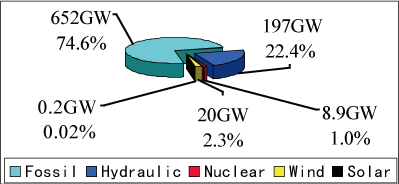 Fig.1 The total capacity of the electric power in the mainland at the end of 2009
The scale of the electricity, as well as the energy in China are very large (just a little less than those in the US). The needs to the energy are still being increased sharply with the strong growth of the economy. For the sustainable development of the society, it is very important to keep the stable supply of the energy.
Energy in China has also some characteristics as follows:
China government has decided to develop more and more clean and renewable energy to change the unreasonable structure of the energy in China. President Hu Jintao has made a declaration that the clean energy will occupy 15% of the total energy in China till 2020. It becomes the common sense in China that nuclear power is a clean and safe energy. Compared to the windy power and the solar power, it is stable and cheap. So the nuclear power is regarded as the only realistic and effective energy, which can be developed in large scale. It becomes one important choice for the Chinese government to develop actively nuclear power as the key policy for the sustainable development of the Chinese society. 3. Status of nuclear power industry3.1 Milestones of China nuclear industry
3.2 System of the nuclear power industryIn China, presently there are 4 national group companies which take the nuclear power operation, design, R&D, and construction as their main business: China National Nuclear Corporation (CNNC, former Ministry of Nuclear Industry), China National Nuclear Construction Corporation, China Guangdong Nuclear Power Corporation (CGNPC), State Nuclear Power Technology Corporation (SNPTC). There are 5 national group companies which take the electric power generation as their main business: China Huaneng Corporation (CHC), China Datang Corporation, China Guodian Corporation, China Huadian Corporation, China Power Investment Corporation (CPI). Among them, CPI is presently the only one which was qualified to be able to operate the nuclear power station as an owner. There are 5 national group companies as the makers of the power machines including the nuclear power equipments and machines: Shanghai Electric Corporation, Dongfang Electric Corporation, Harbin Electric Corporation, The First Heavy Industry Corporation and the Secondary Heavy Industry Corporation.
CNNC has the following main companies: China Institute of Atomic Energy (CIAE, related to research); China Nuclear Power Research and Design Institute ( related to research and design); China Nuclear Power Engineering Company (former BENE, related to design and construction); China Nuclear Power Operation Institute (related to maintenance and operation service); some companies related to the fuel production and spent fuel processing; some of the nuclear power stations such as Qinshan (I), Qinshan (II), Qinshan (III), Tianwan, Fuqing, Sanmen, Hainan, Taohuajinag and so on. CGNPC has the following main companies: CGNPC Nuclear Power Operation Company (related to operation service); CGNPC Nuclear Power Engineering Company (related to construction); Zhongkehua Nuclear Power Technology Research Institute (related to R&D, maintenance, operation service); some of the nuclear power stations such as Daya bay, Ling’ao, Hongyanhe, Ningde, Yangjiang, Taishan, Dafan and so on. SNPTC has the following main companies: Shanghai Nuclear Engineering Research and Design Institute (SNEPDI, related to design); SNPTC Nuclear Power Operation Company (related to operation service); SNPTC Nuclear Power Engineering Company (related to construction); SNPTC Automatic Control and Instrument Company; Shandong Electric Power Design Institute; SNPTC R&D Center and Demonstration Nuclear Power Station. CPI has some of the nuclear power stations such as Haiyang, Pengze and so on. CHC has some of the nuclear power stations such as Shidaowan. 3.3 Nuclear power stations in operation and under constructionAs shown in the table 1, presently in the mainland of China, there are 11 units of reactors with the total capacity of 8.9 GWe in operation, while 20 units with the total capacity of 21.9 GWe under construction.
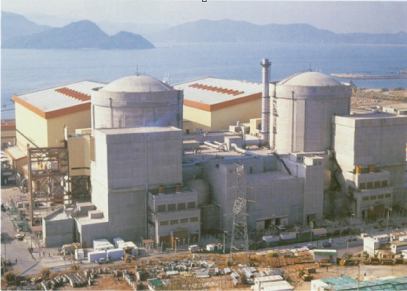 Fig.2 Daya Bay Nuclear Power Plant[1]
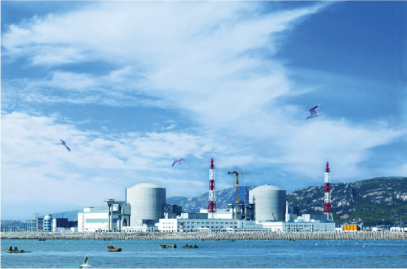 Fig.3 Tianwan Nuclear Power Plant[2]
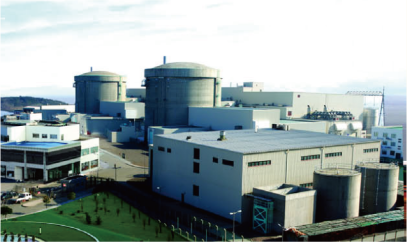 Fig.4 Qinshan Phase III CANDU nuclear power plant[3]
According to the “long-term development plan for nuclear power industry (from 2005 to 2020)”, till 2020, the total capacity of the nuclear power in operation reaches 40GWe, the total capacity under construction 18GWe. Presently, the figure “40GWe” is expected to be completed till 2015.
3.4 R&D of nuclear powerEven though there is no national program on R&D of nuclear energy so far, from the roadmap Chinese nuclear industry walked during the past 50 years, it can be seen that the R&D of nuclear energy in China is following a 3-step strategy of PWR-FBR-Fusion reactor and the closed nuclear fuel cycle principle. On Feb. 9 of 2006, China government issued a document named “State long-term science technology development program (from 2005 to 2020)”, in which “ a Large-scale advanced PWR demonstration power station and a HGTR demonstration power station” are listed as one of “16 national key projects”, while “FBR and Thermal-nuclear fusion reactor” are listed as “the frontier techniques”.
Through the development more than 50 years, as the achievements of R&D, China has constructed the complete system of nuclear industry and a preliminary closed U-Pu cycle system. China already has the capacity to design and construct by itself the 300-MWe PWR and 600-MWe PWR, which are being operated in Qinshan I and Qinshan II. On the basis of M310-type PWR of France, China has also developed a 1000-MWe PWR named CPR1000, which are being constructed in Ling’ao II. Presently R&D of nuclear power in China is focused on the following aspect:
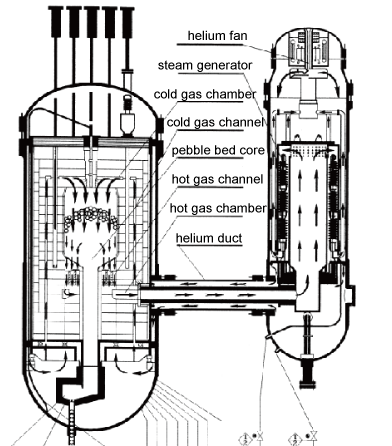 Fig.5 10MWt HTGR[4]
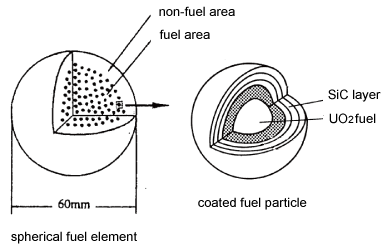 Fig.6 Pebble fuel element of HTGR [4]
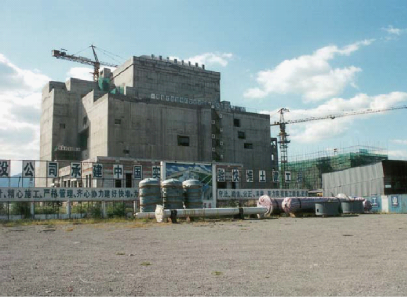 Fig.7 China Experimental Fast Reactor (CEFR)[5]
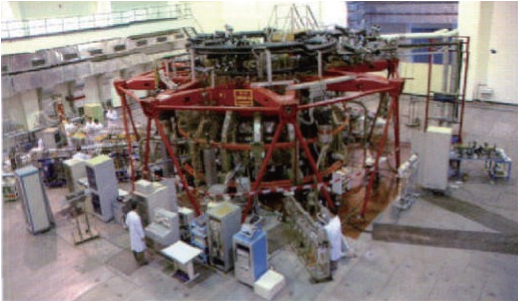 Fig.8 HL-2A Tokamak device[7]
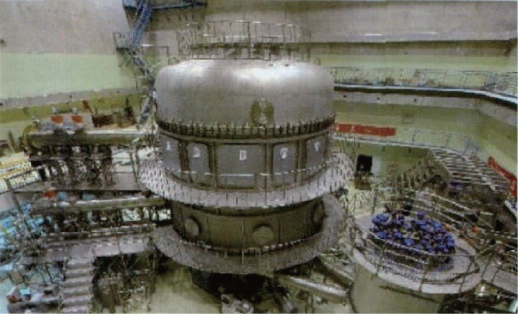 Fig.9 EAST superconducting Tokamak device[7]
3.5 Nuclear safetyThe National Nuclear Safety Administration (NNSA) in China is the licensing and regulatory body for nuclear safety and radioactive safety. It issued policies and programs, administrative regulations rules, standards and criteria on nuclear safety. All these are in agreement with those issued by NRC. The procedures for licesing and surveillance in China are similar to those in the US. NNSA is responsible for the supervision on the licensing, designing, manufacturing, installation, and non-destructive testing of nuclear equipment. It is also responsible for the qualification management of professionals including operators of reactors. NNSA has a Nuclear Safety and Radioactive Safety Center for R&D in nuclear safety and safety review of nuclear facilities, a Nuclear Safety and Environment Protection Expert Committee for consultation, and 7 surveillance stations for the in-site surveillance around the country. It is assured that the safety of all the nuclear facilities in China is under control. China still keeps the good records in nuclear safety so far.
3.6 International cooperationThe histry of Chinese nuclear industry is also a histry of international cooperation. It is well known Daya Bay nuclear power station was constructed under the cooperation from France, while Qinshan III from Canada, Tianwan from Russia, now AP1000 technique transfer from the US. Even in the Qinshan I and Qinshan II which were desiganed and constructed by Chinese itself, the reactor pressure vessels were imported from Japan. For the R&D of the next generation reactor such as CAP1400, FR, HTGR, ADS, ITER, as well as the fuel cycle techniques, China is keeping close cooperations with the US, Russia, France, Germany, Japan, Korea and so on.
4. Future of nuclear power industry
Some experts gave a prediction for Chinese electric generation and the electric capacity in the future as follows: up to the year of 2020, the general electric generation is 7430G KWh, while the total capacity of the electric power reaches 1650 GWe in operation; up to the year of 2030, the general electric generation is 10450G KWh, while the total capacity of the electric power reaches 2300 GWe in operation.
Some experts in nuclear industry gave a prediction for Chinese nuclear power capacity in the future as follows: up to the year of 2020, the capacity of the nuclear power reaches 82 GWe in operation with the share of 5%; up to the year of 2030, the capacity of the nuclear power reaches 207 GWe in operation with the share of 9%. Based on the current status and the previous prediction, the future of Chinese nuclear power industry is foreseen as follows; CAP1400 will become the dominant type of the reactors used in the nuclear power stations in 2020. The demonstration FBR will be developed in 2020. The commercial FBR will become the main type constructed in the nuclear power stations from 2030. A large-size commercial reprocessing plant will be completed in 2020. The nuclear fuel cycle will be completely closed in 2030. 5. Conclusions
To meet the growth of the economy, energy development and energy security become a national strategy in China. The clean energies, especially the nuclear power are being developed with the highest priority against the global climate change.
Though more and more nuclear power stations are being developed in China, the share of the nuclear power is still low. R&D of nuclear power in China is following a 3-step strategy of PWR-FBR-Fusion reactor and the closed nuclear fuel cycle principle for the sustainable development of nuclear energy. The safety of all the nuclear facilities in China is under control. It is essential to keep the international cooperation for the development of nuclear power in the world. References
|
||||||||||||||||||||||||||||||||||||||||||||||||||||||||||||||||||||||||||||





